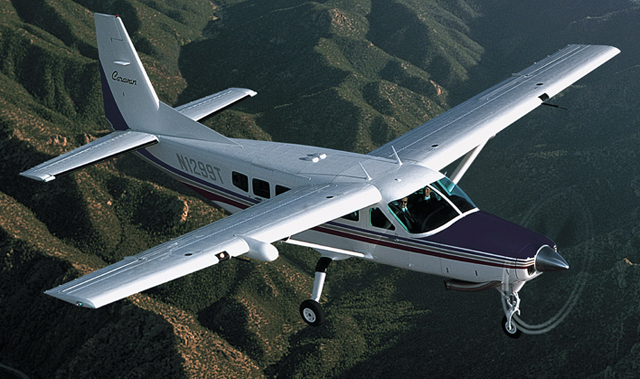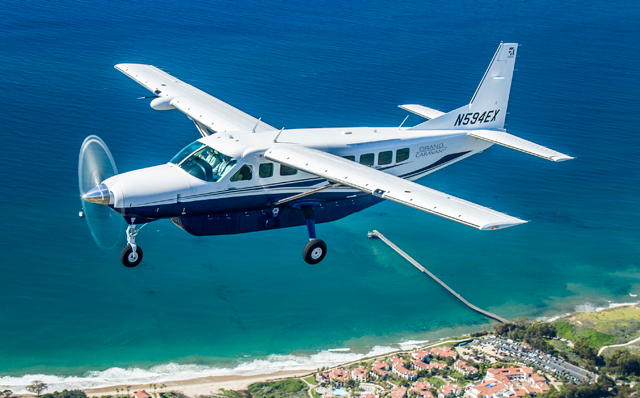Cessna’s 208 Caravan has fulfilled many roles over its 30-year lifetime – from commuter airliner to feeder freighter, and from military transport to sightseeing aircraft – notching up 13 million flying hours in 100 countries along the way. Now, as the Pratt & Whitney Canada PT6A-powered single-engined utility turboprop nears its 2,500th delivery, Cessna is increasingly pushing the Caravan’s qualities in the special mission arena. At June’s Paris air show, parent Textron Aviation debuted the newly-configured Grand Caravan EX demonstrator, sporting a variety of special mission features, including surveillance console and medical stretcher. It now plans to display the demonstrator at industry events around the world as it attempts to prove that the Caravan is as relevant to the market today as it has ever been.
The Wichita manufacturer delivered 95 Caravans last year, with just under a fifth to be operated in a special mission role. That proportion is a “step level” increase on previous ratios, says Christi Tannahill, senior vice-president of turboprops at Textron Aviation, and is largely thanks to the efforts of Textron’s special mission business, with its 78 dedicated staff. Textron’s acquisition of Beechcraft last year brought with it – along with the King Air range – Beechcraft’s “very robust” special mission business, geared to deliver versions of the King Air and T-6 military trainer. Now the Caravan benefits from a special mission expertise that “goes right across our product line”, says Tannahill.

Textron Aviation
The merger of the two rival Wichita-based general aviation names brought together the market-leading single-engine turboprop and its equivalent in the world of twinprops, the King Air. Although both are similarly-sized and have a reputation for rugged dependability and short-runway performance, the King Air flies further and higher, carries more payload and is more than three times the price of a Grand Caravan EX. Neither does the Caravan compete with other established single-engine turboprops, such as the Pilatus PC-12 and Daher TBM 900, which are faster, smaller, pricier and pitched mainly at the owner-flyer market. Instead, after many years of being almost in a class of its own, the Caravan is facing new competition in the form of the Quest Kodiak and Mahindra Airvan 10 single-engined turboprops, as well as the reborn Viking Twin Otter twinprop.
All these manufacturers are determined to tap into what has traditionally been the Caravan’s market, for low-cost, nine- to 12-seat utility aircraft able to perform a multiplicity of roles. Since launching the Series 400 Twin Otter programme in 2007, Vancouver Island-based Viking has delivered just over 70 of the PT6A-34-powered aircraft and is building the twinprops at a rate of roughly 25 aircraft a year. Idaho-based Quest Aircraft has delivered around 140 of its Kodiak since it entered service in 2007, and now has the financial backing of Japanese owners to fulfil its ambition of becoming “the leading manufacturer of single-engined turboprops in the world”. India’s Mahindra is developing the Airvan 10, a 10-seat stretch and turboprop-powered variant of its Airvan 8 piston, originally produced by Australia’s Gippsland.
Tannahill says Cessna’s reaction to this new competition is to “continue to focus on what our aircraft does well”, and to “speak to our customers and understand what their expectations are”. Adam Blackford, business leader on the Caravan, says: “We talk about what the product can do and what it has proven over 30 years. It is very robust and versatile.”
However, Cessna has done more than just listen and talk. In 2013 it began deliveries of the Grand Caravan EX – a repowered version of the larger Caravan that originally entered service in 1990 – featuring PT6A-140 engines, which delivered a 38% improvement in rate of climb, and aimed at operators in hot and high environments. The EX will make up about 85% of production this year, says Tannahill, although Cessna has no plans to halt the 208, which still has an appeal among the owner-operator community, she says.
Thirty-three years after launching the 208 programme, Cessna now produces four versions of the Caravan: the Grand Caravan EX in both conventional and amphibian configurations, as well as the standard 208 in standard and floatplane versions. Some 200 of the Grand Caravan EX have been delivered, around a fifth of which are amphibians. Cargo remains one of the main missions of the Caravan – FedEx was one of the launch operators and remains the biggest today, with a fleet of some 170 aircraft.

Textron Aviation
However, as the programme ages, the uses the Caravan is being put to “continue to expand”, insists Blackford, with commercial airline service being an important niche, particularly in the growing markets of Asia, where remote communities need to be connected to mainline services. “We are seeing EXs being flown on city pairs that previously have not had a service,” says Tannahill. On some of these routes the Caravan’s adaptability proves its worth, with operators regularly switching from primarily passenger to cargo configuration. “It’s an aircraft suited to changing gears,” she says.
With 75% of its production exported, South America, Asia and Africa are the biggest markets for the Caravan. China – as it is for many general aviation manufacturers – is crucial, with its crying need for everything from airline pilot training aircraft to commuter shuttles serving remote communities. In 2012, Cessna and China Aviation Industry General Aircraft (CAIGA) announced a joint venture to carry out final assembly of Grand Caravan EXs in China for the Chinese market. Cessna also has a deal with AVIC to assemble and deliver Citation XLS+ business jets in China.
The Shijiazhuang-based CAIGA venture has just gained approval to carry out maintenance, but Tannahill says it will move to final assembly under its own production certificate within 18 months. “We will begin delivering the first kits in quarter four, and they will begin building them up next year. We are expecting audits between the FAA [Federal Aviation Administration] and the Chinese authorities in the latter part of 2015,” she says. Orders for amphibian Grand Caravan EXs in particular have been strong since the joint venture was established, with customers including Meiya Air for aerial sightseeing in Wuzhizhou island and Joy Air for charter tourism flights in Shanghai, Zhoushan and Shengsi islands.
Other changes for the passenger version of the Caravan include a new standard interior, with seats that are 5% lighter than their predecessors, a lightweight headliner and a lower sidewall. Around 20 aircraft fitted with the new cabin have been delivered so far. “It was welcome as we hadn’t had an interior upgrade for many years,” says Blackford.
Earlier this year, EASA approved a 14-seat configuration for the Grand Caravan EX, something that could spur other authorities to approve the variant. Tannahill says it will “allow many new uses for the aircraft in Europe”. Another possibility – although Blackford says it is simply something his engineering team have been asked to evaluate – is a weight increase. Maximum take-off weight is currently 3,995kg (8,807lb). “We have no specific targets, but we are in talks with the engineers about moving it higher,” he says.
Tannahill believes that, despite the new competition and the fact that the programme is entering its fourth decade, there is plenty life left in the Caravan. “We don’t see many limitations,” she says. “As long as customers want it, we will go on building it.”
Source: Flight International



















